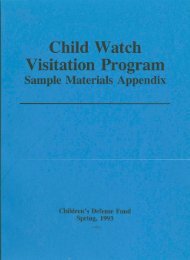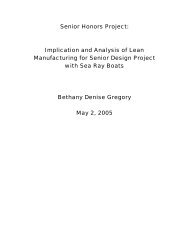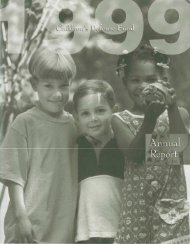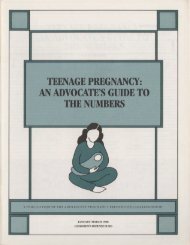children out of school in america - University of Tennessee Digital ...
children out of school in america - University of Tennessee Digital ...
children out of school in america - University of Tennessee Digital ...
Create successful ePaper yourself
Turn your PDF publications into a flip-book with our unique Google optimized e-Paper software.
Bureau is <strong>in</strong>terested primarily <strong>in</strong> descriptions <strong>of</strong> the<br />
types <strong>of</strong> programs be<strong>in</strong>g funded under the Vocational<br />
Education Amendments. Congressmen and<br />
others try<strong>in</strong>g to evaluate the effectiveness <strong>of</strong> certa<strong>in</strong><br />
legislation are more <strong>in</strong>terested <strong>in</strong> who is be<strong>in</strong>g served<br />
by the various programs. If data on programs are<br />
to be useful, both <strong>of</strong> these <strong>in</strong>terests must be accommodated.<br />
5. NCES Survey<br />
A survey conducted by NCES <strong>in</strong> the Spr<strong>in</strong>g <strong>of</strong><br />
1970, as part <strong>of</strong> the 1970 School Staff<strong>in</strong>g Survey,<br />
attempted to show the extent to which special <strong>in</strong>struction<br />
was be<strong>in</strong>g provided to handicapped pupils<br />
<strong>in</strong> local public <strong>school</strong>s. However, because the data<br />
was collected from a survey <strong>of</strong> only approximately<br />
2,000 elementary and secondary <strong>school</strong>s, no state by<br />
state breakdowns <strong>of</strong> the data are available. The survey<br />
does give data for each <strong>of</strong> n<strong>in</strong>e handicapp<strong>in</strong>g<br />
conditions. NCES estimated that 4,752,000 handicapped<br />
pupils were enrolled <strong>in</strong> public <strong>school</strong>s <strong>in</strong> the<br />
United States <strong>in</strong> Spr<strong>in</strong>g 1970, and that almost 3<br />
million <strong>of</strong> these were receiv<strong>in</strong>g some special services.<br />
However, this estimate exceeds the 1971-72 estimate<br />
prepared by the Bureau <strong>of</strong> Education for the Handicapped,<br />
which said that less than 3 million <strong>of</strong> the<br />
total number <strong>of</strong> <strong>children</strong> <strong>in</strong> the country (ages 0-21<br />
years old) got special education services. However,<br />
their <strong>in</strong>cidence estimates for various handicapp<strong>in</strong>g<br />
conditions differed from those prepared by the Bureau<br />
<strong>of</strong> Education for the Handicapped.<br />
6. OCR Survey<br />
The Annual Fall Elementary and Secondary<br />
School Civil Rights Survey conducted by OCR also<br />
conta<strong>in</strong>s some useful <strong>in</strong>formation on the number <strong>of</strong><br />
pupils be<strong>in</strong>g served by various special education<br />
programs. The OCR data are particularly useful<br />
because they provide the only racial and ethnic<br />
breakdown available at the federal level on <strong>children</strong><br />
classified accord<strong>in</strong>g to various handicaps. We share<br />
OCR's concerns ab<strong>out</strong> the potential for assign<strong>in</strong>g<br />
students discrim<strong>in</strong>atorily to special education classes.<br />
We are also concerned that <strong>children</strong> are be<strong>in</strong>g misclassified<br />
and wrongly placed <strong>in</strong> special programs.<br />
Although there is a problem because the OCR<br />
data do not precisely <strong>in</strong>dicate the handicapp<strong>in</strong>g conditions<br />
be<strong>in</strong>g served by various special education<br />
362<br />
programs, it is the only data which give racial or<br />
ethnic breakdowns and is also available by district.<br />
OCR's Fall 1973 Survey was the first one to provide<br />
any sort <strong>of</strong> <strong>in</strong>formation on the various types <strong>of</strong> special<br />
education programs. The 1973 survey was<br />
based on a smaller sample than the 1972 survey, but<br />
it accounts for over 50 percent <strong>of</strong> the total enrollment<br />
<strong>in</strong> the country's public elementary and secondary<br />
<strong>school</strong>s and ab<strong>out</strong> 90 percent <strong>of</strong> the total<br />
m<strong>in</strong>ority enrollment.<br />
B. Programs for Children <strong>of</strong> Limited<br />
English-Speak<strong>in</strong>g Ability<br />
We know that non-English-speak<strong>in</strong>g <strong>children</strong> and<br />
<strong>children</strong> <strong>of</strong> limited English-speak<strong>in</strong>g ability are likely<br />
to be excluded from <strong>school</strong> and from appropriate<br />
educational programs. We wanted, therefore, to<br />
obta<strong>in</strong> whatever data was available on the number<br />
<strong>of</strong> such <strong>children</strong> be<strong>in</strong>g served by special programs <strong>in</strong><br />
order to ascerta<strong>in</strong> the proportion <strong>of</strong> such <strong>children</strong><br />
whose special needs were not be<strong>in</strong>g met. We contacted<br />
the program <strong>of</strong>ficers responsible for adm<strong>in</strong>ister<strong>in</strong>g<br />
ESEA Title VII, ESEA Title T, ESEA Title I<br />
(Migrant), ESEA Title III, and the Emergency<br />
School As istance Act. There is no composite data<br />
available at the federal level on the number <strong>of</strong> <strong>children</strong><br />
be<strong>in</strong>g served by various bil<strong>in</strong>gual or other programs<br />
whose purpose is to <strong>in</strong>crease the English<br />
speak<strong>in</strong>g-ability <strong>of</strong> certa<strong>in</strong> <strong>children</strong>.<br />
I. ESEA Title VIl<br />
The Division <strong>of</strong> Bil<strong>in</strong>gual Education, which is<br />
responsible for adm<strong>in</strong>ister<strong>in</strong>g ESEA Title VIT, had<br />
the best data available, which was only on the number<br />
<strong>of</strong> students be<strong>in</strong>g served <strong>in</strong> the bil<strong>in</strong>gual projects<br />
funded under Title VII. They had data available for<br />
fiscal years 1970 through 1973, by project, on the<br />
estimated pupil participation, the dom<strong>in</strong>ant language<br />
served, and fund<strong>in</strong>g levels. However, the data provided<br />
were estimated participants rather than actual<br />
participants. They did not give the percentage <strong>of</strong> the<br />
pupils who came from environments where the<br />
dom<strong>in</strong>ant language is one other than English or the<br />
percentage who have limited English-speak<strong>in</strong>g ability.<br />
When data are requested on the number <strong>of</strong><br />
participat<strong>in</strong>g pupils who are <strong>of</strong> limited Englishspeak<strong>in</strong>g<br />
ability, attention must be given to the manner<br />
<strong>in</strong> which this figure is determ<strong>in</strong>ed, i.e., there














